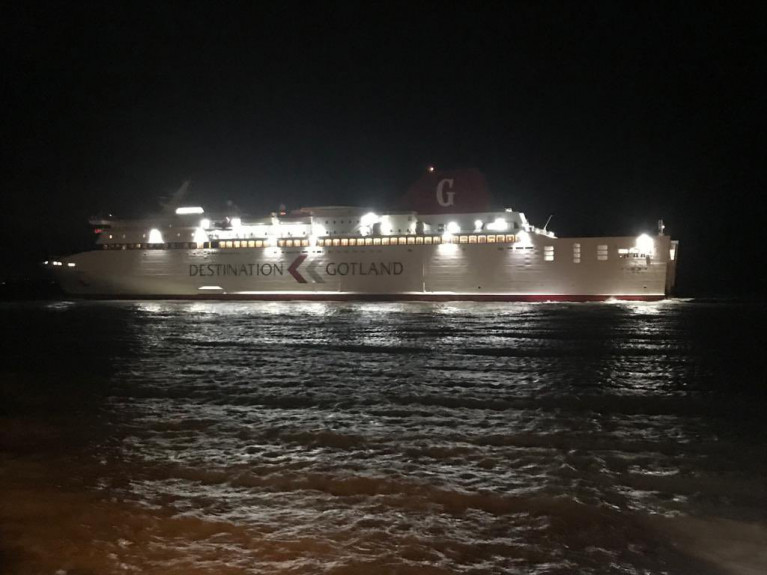The chartered Visby became the first freight-ferry of DFDS new Ireland-mainland Europe ro-ro route to operate the inaugural 'inbound' sailing from Dunkirk in France with an arrival in Rosslare Europort last night, writes Jehan Ashmore.
As Afloat previously reported, the chartered Swedish flagged Visby is from Baltic Sea operator Destination Gotland which has routes from the Nordic nation to Visby on the island of Gotland. The Visby of 29,746 gross tonnage is the largest of three ropax ferries that DFDS have operating on the 6 days a week sailing schedule which takes 23 hours 45 minutes.
Likewise bookings were also full on two outbound sailings from Rosslare which took place on Saturday, the launch day of the new route's maiden sailing aptly carried out by the DFDS owned Lithuanian flagged Optima Seaways of 25,206grt.
Following the 'Optima's maiden 1400hrs sailing the second took place at 2300 and was carried by another chartered ropax the Cypriot flagged Kerry of 24,418grt. This ropax also arrived yesterday at the French port close to the markets of the BeNeLux nations along with Germany.
The new Ireland-France link offers a vital trading route alternative to a post Brexit UK and the landbridge involving two short-sea routes. In addition the new DFDS route provides truck drivers to avoid new customs checks and congestion in Britain of recent weeks and keep trade transportation logistics only within EU nations.
Each of the three ropax ferries have a capacity of up to 125 units. The ferries take a mix of freight vehicles in the form of driver accompanied trucks, un-accompanied trailers which include ambiant and refridgerated units.
With the entry of Visby on the new DFDS route, Afloat explores briefly into the design of this 'fast ropax' built by the Guangzhou Shipyard in China and which was launched in 2003 onto the Baltic Sea operating a 'full' service catering for 1,500 passengers, 500 cars and 1,800 freight lane metres. In addition 112 'day' cabins provided given two short-sea routes of around 3 hours duration. This compared to the DFDS 24 hour route, where the operator has Visby allocated with just 92 cabins and seemingly to reflect the freight-only role.
Visby's new freight only mode also applies to the similar ropax pair of Optima Seaways and Kerry. They were built by Cantiere Navale Visentini in Italy, where the former DFDS owned ropax built in 1999 has 2,115 freight lane metres which is marginally larger than the 2003 built Kerry's 2,030m. The ropax pair can take passengers and cars in addition accommodation for 80 passenger cabins with 288 beds.
According to DFDS freight drivers will be comfortably accommodated in their own COVID-19 safe cabins (all with private facilities). Afloat adds the route transits through the entire length of the English Channel as Dunkirk (Dunkerque) port is located on the North Sea.
Visby's first outward and corresponding return sailing to Dunkirk is scheduled to take place tonight with a departure time of 2200hrs. Around an hour before, Optima Seaways which launched the route from Rosslare is due to complete the first ever round trip undertaken of the three-strong fleet.































































